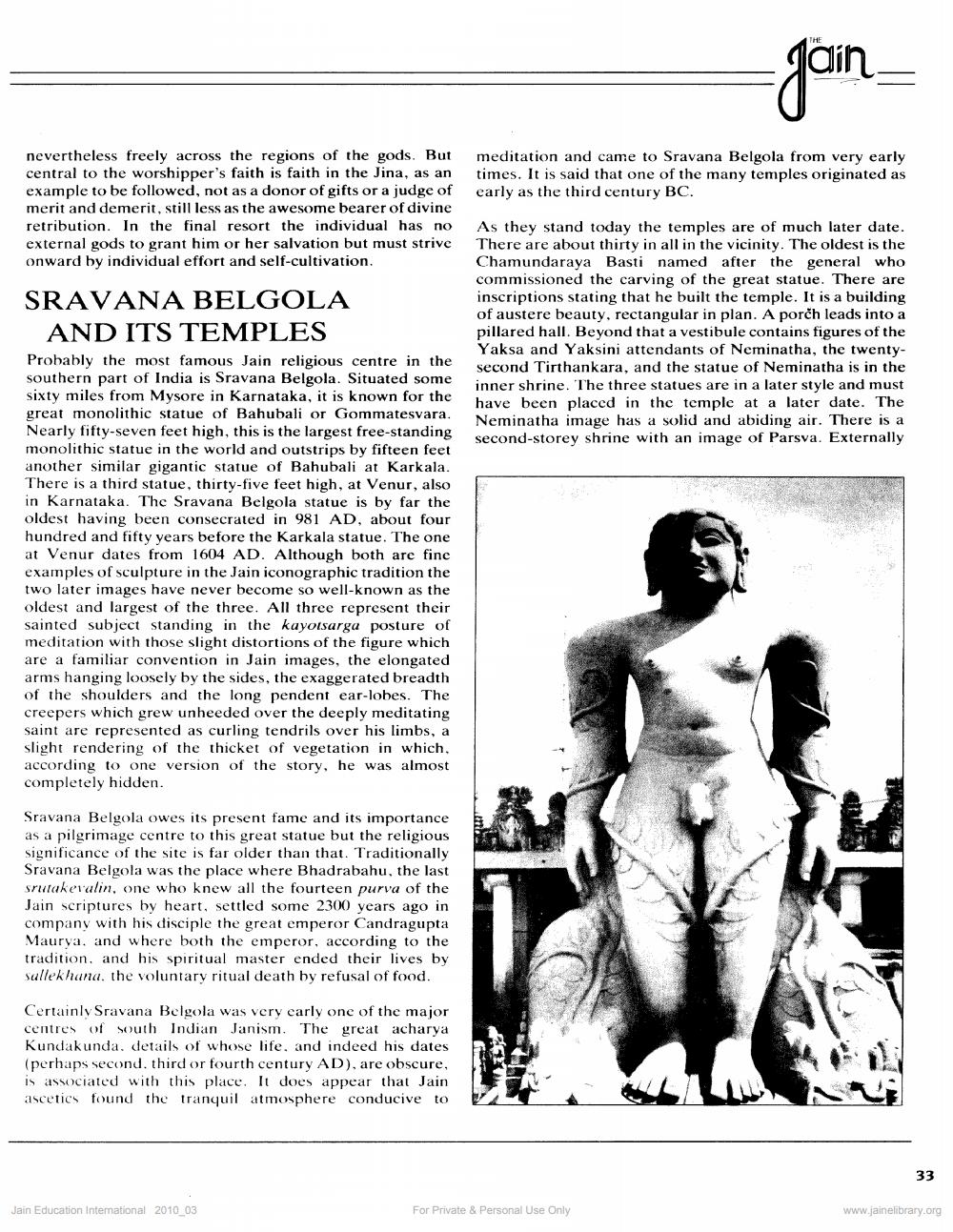________________
meditation and came to Sravana Belgola from very early times. It is said that one of the many temples originated as early as the third century BC.
nevertheless freely across the regions of the gods. But central to the worshipper's faith is faith in the Jina, as an example to be followed, not as a donor of gifts or a judge of merit and demerit, still less as the awesome bearer of divine retribution. In the final resort the individual has no external gods to grant him or her salvation but must strive onward by individual effort and self-cultivation.
As they stand today the temples are of much later date. There are about thirty in all in the vicinity. The oldest is the Chamundaraya Basti named after the general who commissioned the carving of the great statue. There are inscriptions stating that he built the temple. It is a building of austere beauty, rectangular in plan. A porch leads into a pillared hall. Beyond that a vestibule contains figures of the Yaksa and Yaksini attendants of Neminatha, the twentysecond Tirthankara, and the statue of Neminatha is in the inner shrine. The three statues are in a later style and must have been placed in the temple at a later date. The Neminatha image has a solid and abiding air. There is a second-storey shrine with an image of Parsva. Externally
SRAVANA BELGOLA
AND ITS TEMPLES Probably the most famous Jain religious centre in the southern part of India is Sravana Belgola. Situated some sixty miles from Mysore in Karnataka, it is known for the great monolithic statue of Bahubali or Gommatesvara. Nearly fifty-seven feet high, this is the largest free-standing monolithic statue in the world and outstrips by fifteen feet another similar gigantic statue of Bahubali at Karkala. There is a third statue, thirty-five feet high, at Venur, also in Karnataka. The Sravana Belgola statue is by far the oldest having been consecrated in 981 AD, about four hundred and fifty years before the Karkala statue. The one at Venur dates from 1604 AD. Although both are fine examples of sculpture in the Jain iconographic tradition the two later images have never become so well-known as the oldest and largest of the three. All three represent their sainted subject standing in the kayotsarga posture of meditation with those slight distortions of the figure which are a familiar convention in Jain images, the elongated arms hanging loosely by the sides, the exaggerated breadth of the shoulders and the long pendent ear-lobes. The creepers which grew unheeded over the deeply meditating saint are represented as curling tendrils over his limbs, a slight rendering of the thicket of vegetation in which according to one version of the story, he was almost completely hidden.
Sravana Belgola owes its present fame and its importance as a pilgrimage centre to this great statue but the religious significance of the site is far older than that. Traditionally Sravana Belgola was the place where Bhadrabahu, the last srutakeralin, one who knew all the fourteen purva of the Jain Scriptures by heart, settled some 2300 years ago in company with his disciple the great emperor Candragupta Maurya, and where both the emperor, according to the tradition, and his spiritual master ended their lives by sullekhana, the voluntary ritual death by refusal of food.
Certainly Sravana Belgola was very early one of the major centres of South Indian Janism. The great acharya Kundakunda, details of whose life, and indeed his dates (perhaps second third or fourth century AD), are obscure, is associated with this place. It does appear that Jain ascetics found the tranquil atmosphere conducive to
33
Jain Education Intemational 2010_03
For Private & Personal Use Only
www.jainelibrary.org




